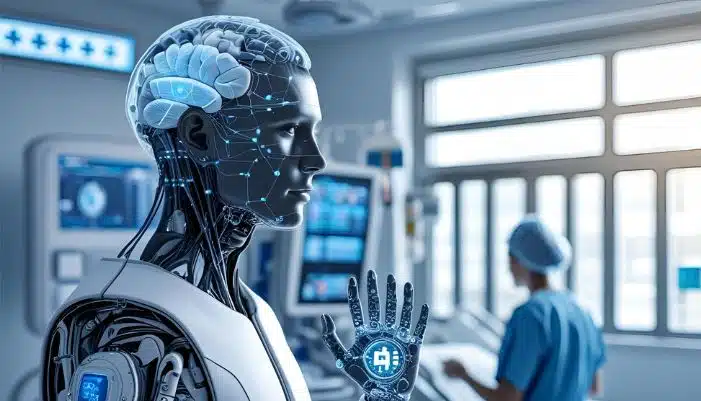The healthcare landscape is undergoing a remarkable transformation, driven by advances in artificial intelligence. Once limited by human capabilities and traditional diagnostic tools, early disease detection has found a powerful ally in Artificial Intelligence technologies.
These sophisticated systems can now analyze vast amounts of medical data with unprecedented speed and accuracy, identifying patterns that might escape even the most experienced clinicians.
Recent statistics reveal that early detection can increase survival rates for many serious conditions by 30-50%. This significant improvement demonstrates why healthcare providers worldwide are investing billions in AI diagnostic technologies. The promise is clear: catching diseases earlier means more effective treatments, reduced healthcare costs, and, most importantly, saved lives.
How AI Is Changing the Diagnostic Process
Traditional diagnostic processes often involve multiple steps, consultations, and tests that can take weeks or even months. Artificial Intelligence is streamlining this journey in remarkable ways:
- Pattern recognition – Smart technology systems can identify subtle abnormalities in medical images that human eyes might miss.
- Predictive analytics – Algorithms can forecast disease progression based on current data.
- Risk assessment – AI tools can evaluate patient risk factors more comprehensively than conventional methods.
Dr. Sarah Chen, a leading oncologist at Memorial Hospital, explains: “What used to take our team days of analysis can now be accomplished in minutes with our Artificial Intelligence diagnostic platform. This speed doesn’t just improve efficiency—it fundamentally changes what’s possible in early intervention.”
The Technology Behind AI Diagnostics
The technological foundation of AI diagnostics rests on several sophisticated approaches. Machine learning algorithms, particularly deep learning neural networks, form the backbone of many diagnostic smart systems. These networks learn from millions of examples, gradually improving their accuracy in identifying disease markers.
Computer vision technologies enable AI to analyze medical images like X-rays, MRIs, and CT scans with remarkable precision. Natural language processing allows systems to extract relevant information from medical records and research papers.
Many healthcare professionals find relaxation essential after working with these intensive technologies. Some even enjoy recreational activities like visiting Hit’n’Spin during their downtime, finding it helps them return to their critical work with renewed focus and energy.
Real-World Applications Saving Lives Today
From hospital emergency rooms to outpatient clinics, AI is no longer a futuristic concept—it’s an active participant in clinical decision-making. These tools are not replacing physicians but enhancing their capabilities, offering faster, data-driven insights that support earlier and more accurate diagnoses. In many cases, Artificial Intelligence serves as a second pair of expert eyes, reducing the risk of human error and improving diagnostic confidence. As adoption grows, real-world success stories are emerging across specialties, showing how AI is helping save lives every day. AI diagnostic applications are already making a tangible difference across multiple medical specialties:
- Oncology: AI systems can detect cancer cells in tissue samples with over 95% accuracy in some studies. Breast cancer detection through AI-enhanced mammography has shown particularly promising results, identifying suspicious areas that radiologists sometimes miss.
- Cardiology: Heart disease, the leading cause of death worldwide, benefits from AI tools that can predict cardiac events before they occur. One system analyzes ECG readings to identify patients at risk of atrial fibrillation days or weeks before conventional detection methods.
- Neurology: For neurological conditions like Alzheimer’s disease, Artificial Intelligence can identify subtle changes in brain scans years before symptoms become apparent. This extended window for intervention could revolutionize treatment approaches.
Challenges and Ethical Considerations
Despite its promise, AI in healthcare diagnostics faces significant challenges. Data privacy concerns remain paramount, as these systems require access to sensitive medical information. Ensuring this data remains secure while still being useful for AI training represents a delicate balance.
The “black box” problem also persists—many automated intelligence systems cannot easily explain their diagnostic reasoning, creating hesitation among medical professionals who need to understand why a particular diagnosis was reached.
Ethical questions about AI decision-making in healthcare continue to evolve:
- Who bears responsibility when an Artificial Intelligence system misses a diagnosis?
- How do we ensure these technologies don’t exacerbate existing healthcare disparities?
- What role should human oversight play in AI-driven diagnostic processes?
The Future of AI Diagnostics
Looking ahead, the integration of AI with other emerging technologies promises even more revolutionary approaches to disease detection. Wearable devices connected to AI diagnostic systems could provide continuous health monitoring, alerting patients and doctors to concerning changes before they become serious problems.
Genomic analysis powered by AI may soon offer personalized risk assessments based on an individual’s unique genetic profile. This approach could transform preventive medicine, allowing for customized screening schedules and prevention strategies.
Embracing the AI Diagnostic Revolution
The journey toward AI-powered healthcare diagnostics represents one of the most promising developments in modern medicine. While challenges remain, the potential benefits—earlier detection, more accurate diagnoses, and improved patient outcomes—are too significant to ignore.
Healthcare systems that embrace these technologies thoughtfully, addressing ethical concerns while leveraging AI’s analytical power, will be best positioned to deliver the next generation of care. For patients, this revolution offers something invaluable: time, the precious commodity that early detection provides, often making the difference between effective treatment and limited options.
As we continue to refine these technologies, the true measure of success will be found not just in statistical improvements but in the stories of individuals whose lives were saved because a disease was caught at its earliest, most treatable stage.



